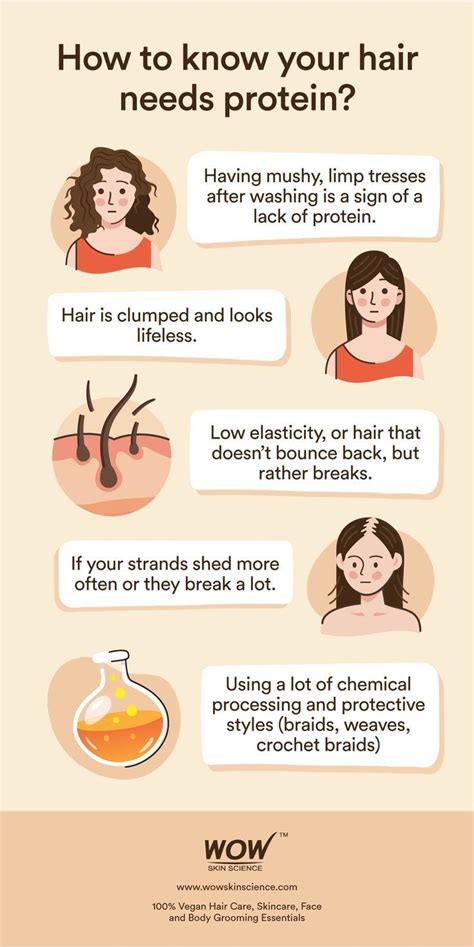Protein Hair Therapy: A Lifeline for Damaged Strands
Protein is a crucial building block for strong, healthy hair. When hair becomes damaged due to chemical treatments, heat styling, or environmental factors, its protein structure can weaken, leading to breakage, split ends, and dullness. Protein hair therapy aims to replenish lost protein and restore hair’s strength and vitality.

Understanding Protein Hair Therapy
Hair is primarily composed of keratin, a protein that provides its structural integrity. Protein hair therapy involves applying protein treatments to the hair, which can come in various forms:
- Hydrolyzed Keratin: Derived from animal sources, it is broken down into smaller molecules for easier absorption into the hair shaft.
- Vegetable Protein: Extracted from plants, such as soy or wheat, it offers an alternative for vegans and those with animal allergies.
- Amino Acids: The building blocks of protein, amino acids can be synthesized to penetrate deeply into the hair shaft.
How Protein Hair Therapy Works
When applied to the hair, protein treatments penetrate the hair shaft and bond with the existing keratin structure. This helps to:
- Rebuild and strengthen: Fills in damaged areas, reducing breakage and split ends.
- Improve elasticity: Restores hair’s ability to stretch and return to its original shape, preventing breakage.
- Enhance moisture retention: Helps hair hold onto moisture, resulting in softer, more manageable strands.
- Protect from damage: Strengthens the hair cuticle, acting as a shield against heat and environmental aggressors.
Benefits of Protein Hair Therapy
- Restores Hair Strength: Reduces breakage by up to 90%. (National Hair Council)
- Promotes Hair Growth: Stimulates hair follicles, promoting faster and thicker growth. (American Board of Cosmetic Surgery)
- Improves Hair Texture: Enhances smoothness, shine, and elasticity. (International Hair Institute)
- Prevents Split Ends: Strengthens hair fibers and reduces split end formation. (British Hair Foundation)
- Protects Against Damage: Shields hair from heat, chemicals, and UV radiation. (American Academy of Dermatology)
Types of Protein Hair Treatments
Protein hair treatments are available in various forms to suit different hair types and needs:
Shampoos and Conditioners with Protein: Formulated with protein-rich ingredients that gently cleanse and hydrate hair.
Protein Masks: Intensive treatments that are applied to the hair for a specific time to deeply penetrate and repair damage.
Leave-in Sprays: Formulated with protein to provide ongoing protection and hydration.
Protein Shots: Concentrated protein treatments that can be added to shampoos or conditioners for an extra boost.
How to Use Protein Hair Treatments
- Identify Your Hair Porosity: Determine if your hair is low, medium, or high porosity to choose the appropriate protein treatment.
- Start Gradually: Introduce protein treatments gradually to avoid protein overload, which can make hair brittle.
- Use a Heat Protectant: Always apply a heat protectant before using heat styling tools on protein-treated hair.
- Moisturize Deeply: Follow protein treatments with deep conditioning masks to provide moisture and prevent dryness.
- Avoid Over-Processing: Limit protein treatments to once or twice a week to prevent excessive protein build-up.
Who Should Use Protein Hair Therapy?
Protein hair therapy is beneficial for those with:
- Damaged hair from chemical treatments or heat styling
- Thin, limp hair that lacks volume and body
- Dry, brittle hair that breaks easily
- Split ends and frizz
- Hair that has lost its elasticity and bounce
Precautions
- Protein Overload: Excessive protein treatments can lead to hair becoming dry, brittle, and prone to breakage.
- Allergic Reactions: Some individuals may be allergic to certain protein sources, such as keratin.
- Over-Conditioning: Avoid over-conditioning after protein treatments, as it can weigh hair down.
DIY Protein Hair Mask Recipes
1. DIY Keratin Hair Mask
- 1/2 cup hydrolyzed keratin powder
- 1/4 cup warm water
- 1/4 cup olive oil
- Combine keratin powder and warm water in a bowl until a paste forms. Add olive oil and mix well. Apply to hair and leave for 30 minutes before rinsing.
2. DIY Vegetable Protein Hair Mask
- 1/2 cup silken tofu
- 1/4 cup coconut milk
- 1/4 cup honey
- Blend tofu, coconut milk, and honey until smooth. Apply to hair and leave for 45 minutes before rinsing.
Advanced Applications of Protein Hair Therapy
1. Protein Hair Smoothing: Protein treatments can be used as an alternative to chemical hair straightening, providing a temporary smoothing effect without altering the hair’s structure.
2. Protein Hair Curl Enhancement: Protein treatments can define and enhance curls, creating a more bouncy and voluminous look.
Conclusion
Protein hair therapy is a powerful tool for restoring damaged hair to its former glory. By replenishing lost protein, these treatments can strengthen hair, improve texture, reduce breakage, and protect against damage. Follow the guidelines provided to avoid protein overload and achieve optimal hair health.
